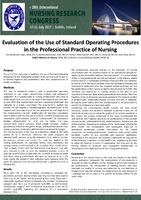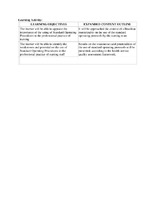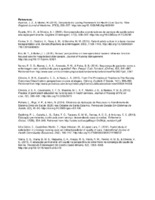| dc.contributor.author | de Moura, Andre Almeida Sr. | en |
| dc.contributor.author | Sales, Camila Balsero | en |
| dc.contributor.author | Bernardes, Andrea | en |
| dc.contributor.author | Gabriel, Carmen Silvia | en |
| dc.contributor.author | Brito, Maria de Fatima Paiva | en |
| dc.contributor.author | Zanetti, Ariane Cristina Braboza | en |
| dc.date.accessioned | 2017-07-07T14:17:52Z | |
| dc.date.available | 2017-07-07T14:17:52Z | |
| dc.date.issued | 2017-07-07 | |
| dc.identifier | INRC17PST145 | en |
| dc.identifier.uri | http://hdl.handle.net/10755/621706 | |
| dc.description | <p>Event Theme: Influencing Global Health Through the Advancement of Nursing Scholarship</p> | en |
| dc.description.abstract | <p><strong>Purpose: </strong>The aim of this study was to evaluate the use of Standard Operating Procedures in the professional practice of the nursing team as well as identify fragilities and potentialities after their implantation in health institutions.</p>
<p><strong>Methods: </strong>This is an evaluation research, with a quantitative approach, structured in two stages: documentary analysis and subsequent application of a questionnaire to the nursing professionals who work in the Health Units of a city in São Paulo state, Brazil, from April to June 2015 (this questionnaire was previously elaborated and validated by a judges’ committee). The questionnaire applied is divided into two segments: sociodemographic characterization of the subjects and items referring to the use, potentialities and fragilities of the protocols implemented. Furthermore, 14 operating procedures were implanted into the locals of study in mid-2012 (nasogastric and nasoenteral catheterization protocol, catheterization by cystostomy, bladder catheterization for relief and delay, vital signs measurement, venous puncture, blood’s sample collection, capillary glycosimetry, intestinal and gastric lavage, tracheostomy cannula care, airway aspiration, medication administration and dressings). The educational process of nursing professionals’ training began on the same occasion. Thereunto for a theoretical reference this study used the evaluation triad of the proposed health services which is composed by: structure, process and results. The study was attended by 247 nursing professionals (nurses, technicians and nursing assistants) who worked in the Basic Health Units, the Family Health Units and the Prehospital Care Service, selected in order to meet the stipulated inclusion criteria: two years of prior contact with the protocols at least. In these circumstances, it should be noted that those nurses, technicians and nursing assistants who were on vacation or medical absence during the period of data collection were excluded from this study. All statistical tests were performed with a significance level of 5% (α=0.05).</p>
<p><strong>Results: </strong>More than half of the interviewed professionals consulted the procedures protocols basis daily, reporting that they were used at least once in the twelve months preceding the survey. There was a statistically significant difference between the variables "professional category" and "daily use of protocols" (p=0.000), as well between "professional category" and "consultation protocols in the last 12 months" (p=0.000), indicating the existence of an association between them. The professionals reported changes in the execution of nursing interventions after the implementation of the operational procedures. Concerning to the association between the knowledge of nursing professionals’ improvement and the participation in the training related to the protocols, a statistically significant result (p=0.009) was obtained, as well as the result derived from the comparison between the intervention interventions (p=0.025). It reinforces the importance of education’s actions in the quality of care improvement because these actions generate positive results. The main fragilities of the implanted protocols pointed to the reduced number of professionals, inadequate physical structure and lack of materials. Among the potentialities were the standardization of materials and the concern about professional and patient safety. Considering the contemporary scenario of health, the triad model structure, process and result is intended to provide subsidies for the systematic practice of evaluating the quality of services provided. In this context, the process component of this study encompassed the potentialities and fragilities perceived by professionals in the services and procedures performed from the implantation, training and use of the protocols. Regarding the evaluation of results established by the same model, the incorporation and subsequent execution of operational procedures showed implications for the clinical competence of nursing professionals, compliance with patient safety standards, quality of care provided and satisfaction of the customer. Concerning to the structure, the research emphasized the importance of the structural preparation of the health units, emphasizing the need to adapt the facilities in terms of organization and resources for the training related to protocols and subsequent development of interventions in the daily practice of nursing professionals.</p>
<p><strong>Conclusion: </strong>According to the results found in the study and based on the health service evaluation framework the reassessment of the protocols is necessary as well the adoption of the strategy of permanent education of the professionals. The introduction of the educational action may have improved the quality of nursing care evidenced by the detection of changes in the way interventions are implemented, the knowledge improvement and the increase in the number of services offered by health units.</p> | en |
| dc.format | Text-based Document | en |
| dc.language.iso | en | en |
| dc.subject | Nursing | en |
| dc.subject | Clinical Protocols | en |
| dc.subject | Quality of Health Care | en |
| dc.title | Evaluation of the use of standard operating procedures in the professional practice of nursing | en |
| dc.type | Poster | en |
| dc.rights.holder | <p>
All rights reserved by the author(s) and/or publisher(s) listed in this item record unless relinquished in whole or part by a rights notation or a Creative Commons License present in this item record.
</p><p>
All permission requests should be directed accordingly and not to the Sigma Repository.
</p><p>
All submitting authors or publishers have affirmed that when using material in their work where they do not own copyright, they have obtained permission of the copyright holder prior to submission and the rights holder has been acknowledged as necessary.
</p> | en |
| dc.description.note | <p>Items submitted to a conference/event were evaluated/peer-reviewed at the time of abstract submission to the event. No other peer-review was provided prior to submission to the Henderson Repository.</p> | |
| dc.type.category | Full-text | en |
| dc.evidence.level | N/A | en |
| dc.research.approach | N/A | en |
| dc.contributor.department | Non-member | en |
| dc.author.details | Andre Almeida de Moura, MSN Sr., RN; Camila Balsero Sales; Andrea Bernardes; Carmen Silvia Gabriel; Maria de Fatima Paiva Brito; Ariane Cristina Braboza Zanetti | en |
| dc.conference.name | 28th International Nursing Research Congress | en |
| dc.conference.host | Sigma Theta Tau International | en |
| dc.conference.location | Dublin, Ireland | en |
| dc.date.conferenceyear | 2017 | |
| dc.description.reviewtype | Abstract Review Only: Reviewed by Event Host | en |
| dc.description.acquisition | Proxy-submission | en |







